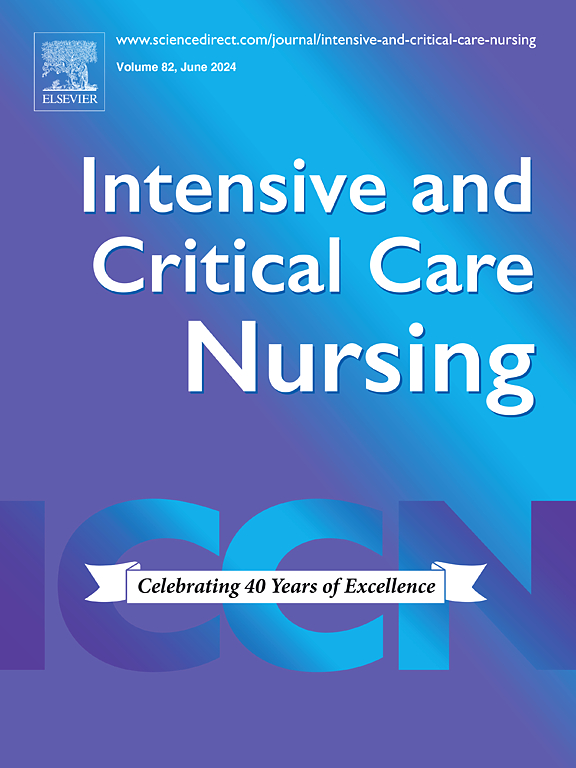CALM ICU指南:关于ICU - Delphi研究中躁动的非药物策略的初步指南
IF 4.7
2区 医学
Q1 NURSING
引用次数: 0
摘要
目的为重症监护病房患者躁动的非药物预防和管理制定初步临床实践指南。方法于2022年1月至5月对来自丹麦和澳大利亚的114名临床医生、研究人员、患者和家属进行了一项改进的三轮德尔菲研究。第一轮德尔菲调查是建立在对躁动管理的非药物干预措施的系统评价基础上的,这是一项改进的总括性评价,包括对重症监护病房患者经历的定性评价,以及在所有卫生保健机构中管理躁动的指南,以及与利益相关者的磋商。如果丹麦和澳大利亚的建议达到75%或更高的共识水平(IQR≥1),则纳入建议。结果初步指南共纳入了63条预防和管理ICU患者躁动的建议。这些建议分为九个主题,形成了一种新的护理模式。主题包括护理原则、躁动评估、躁动原因的识别和治疗、照顾者行为和发展信任关系、家庭参与、社会心理需求、身体需求、个性化护理和与环境相关的干预措施。注意到两国之间和利益攸关方之间的共识存在差异。结论本研究为ICU患者躁动的非药物预防和管理提供了初步指南。该指南强调了发展信任关系、解决患者个体需求和确保组织支持成功实施的重要性。这些准则是初步的,将根据每个国家的情况进行调整、分级并经过公众咨询和专家方法审查。在缺乏既定临床指南的情况下,这些初步指南为ICU临床医生提供了有效管理患者躁动的框架,优先考虑非药物方法,并尽量减少物理和化学约束的使用。研究结果强调需要进一步研究非药物策略来管理躁动。本文章由计算机程序翻译,如有差异,请以英文原文为准。
CALM ICU guidelines: Preliminary guidelines on non-pharmacological strategies for agitation in the ICU − A Delphi study
Aim
To develop preliminary clinical practice guidelines for the non-pharmacological prevention and management of patient agitation in the intensive care unit.
Methods
A modified three-round Delphi study was conducted between January and May 2022 and involved 114 participants from Denmark and Australia, including clinicians, researchers, patients, and family members. The first Delphi round was built on a systematic review of non-pharmacological interventions for managing agitation, a modified umbrella review encompassing qualitative reviews on patient experiences in the intensive care unit and guidelines for managing agitation across all health care settings along with stakeholder consultation. Recommendations were included if they reached a consensus level (IQR ≥ 1) of 75 % or higher in both Denmark and Australia.
Results
A total of 63 recommendations for preventing and managing patient agitation in the ICU were included in the preliminary guidelines. The recommendations were grouped into nine themes, forming a new model of care. The themes include care principles, assessment of agitation, identification and treatment of causes of agitation, caregiver behaviours and developing trusting relationships, family involvement, psychosocial needs, physical needs, individualised care and interventions related to the context. Differences in consensus were noted between the two countries and between stakeholders.
Conclusions
The study provides robust evidence for preliminary guidelines for the non-pharmacological prevention and management of patient agitation in the ICU. The guidelines emphasise the importance of developing trusting relationships, addressing individual patient needs and ensuring organisational support for successful implementation. The guidelines are preliminary and will be tailored to each country, graded and undergo public consultation and expert methodological reviews.
Implications for Clinical Practice
In the absence of established clinical guidelines, these preliminary guidelines offer a framework for ICU clinicians to manage patient agitation effectively, prioritising non-pharmacological approaches and minimising the use of physical and chemical restraints. The findings highlight the need for further research on non-pharmacological strategies to manage agitation.
求助全文
通过发布文献求助,成功后即可免费获取论文全文。
去求助
来源期刊

Intensive and Critical Care Nursing
NURSING-
CiteScore
6.30
自引率
15.10%
发文量
144
审稿时长
57 days
期刊介绍:
The aims of Intensive and Critical Care Nursing are to promote excellence of care of critically ill patients by specialist nurses and their professional colleagues; to provide an international and interdisciplinary forum for the publication, dissemination and exchange of research findings, experience and ideas; to develop and enhance the knowledge, skills, attitudes and creative thinking essential to good critical care nursing practice. The journal publishes reviews, updates and feature articles in addition to original papers and significant preliminary communications. Articles may deal with any part of practice including relevant clinical, research, educational, psychological and technological aspects.
 求助内容:
求助内容: 应助结果提醒方式:
应助结果提醒方式:


